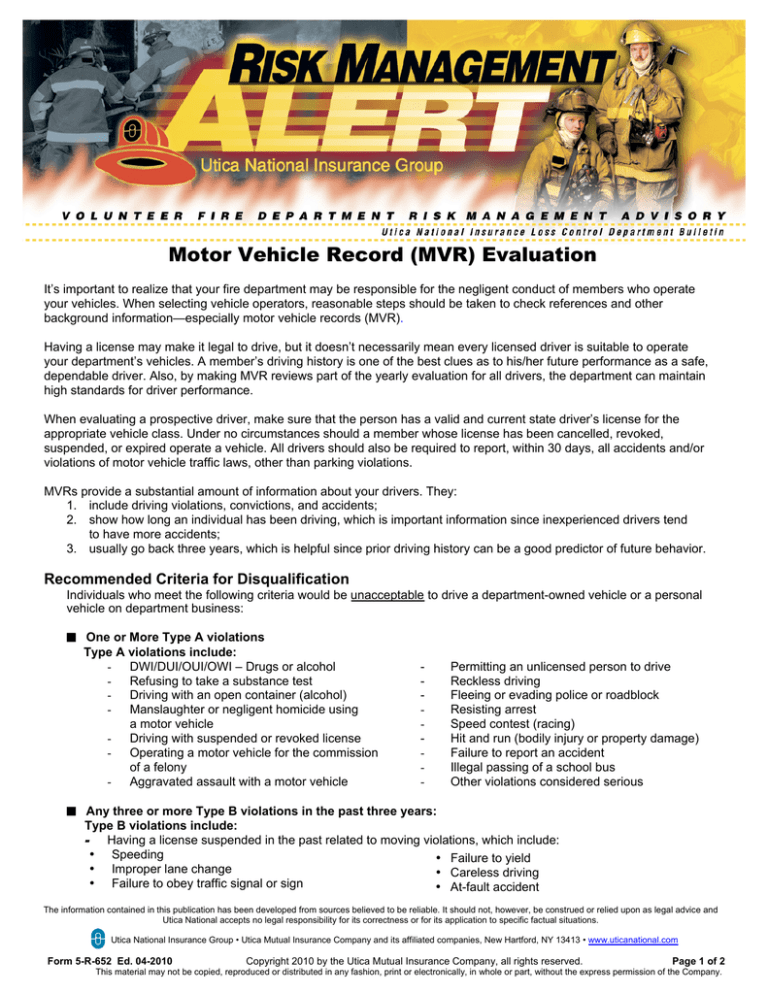
Motor Vehicle Record (MVR) Evaluation
It’s important to realize that your fire department may be responsible for the negligent conduct of members who operate
your vehicles. When selecting vehicle operators, reasonable steps should be taken to check references and other
background information—especially motor vehicle records (MVR).
Having a license may make it legal to drive, but it doesn’t necessarily mean every licensed driver is suitable to operate
your department’s vehicles. A member’s driving history is one of the best clues as to his/her future performance as a safe,
dependable driver. Also, by making MVR reviews part of the yearly evaluation for all drivers, the department can maintain
high standards for driver performance.
When evaluating a prospective driver, make sure that the person has a valid and current state driver’s license for the
appropriate vehicle class. Under no circumstances should a member whose license has been cancelled, revoked,
suspended, or expired operate a vehicle. All drivers should also be required to report, within 30 days, all accidents and/or
violations of motor vehicle traffic laws, other than parking violations.
MVRs provide a substantial amount of information about your drivers. They:
1. include driving violations, convictions, and accidents;
2. show how long an individual has been driving, which is important information since inexperienced drivers tend
to have more accidents;
3. usually go back three years, which is helpful since prior driving history can be a good predictor of future behavior.
Recommended Criteria for Disqualification
Individuals who meet the following criteria would be unacceptable to drive a department-owned vehicle or a personal
vehicle on department business:
■ One or More Type A violations
Type A violations include:
- DWI/DUI/OUI/OWI – Drugs or alcohol
- Refusing to take a substance test
- Driving with an open container (alcohol)
- Manslaughter or negligent homicide using
a motor vehicle
- Driving with suspended or revoked license
- Operating a motor vehicle for the commission
of a felony
- Aggravated assault with a motor vehicle
-
Permitting an unlicensed person to drive
Reckless driving
Fleeing or evading police or roadblock
Resisting arrest
Speed contest (racing)
Hit and run (bodily injury or property damage)
Failure to report an accident
Illegal passing of a school bus
Other violations considered serious
■ Any three or more Type B violations in the past three years:
Type B violations include:
- Having a license suspended in the past related to moving violations, which include:
• Speeding
• Failure to yield
• Improper lane change
• Careless driving
• Failure to obey traffic signal or sign
• At-fault accident
The information contained in this publication has been developed from sources believed to be reliable. It should not, however, be construed or relied upon as legal advice and
Utica National accepts no legal responsibility for its correctness or for its application to specific factual situations.
Utica National Insurance Group • Utica Mutual Insurance Company and its affiliated companies, New Hartford, NY 13413 • www.uticanational.com
Form 5-R-652 Ed. 04-2010
Copyright 2010 by the Utica Mutual Insurance Company, all rights reserved.
Continued on nextPage
page.1 of 2
This material may not be copied, reproduced or distributed in any fashion, print or electronically, in whole or part, without the express permission of the Company.
■
■
Other Unacceptable Criteria:
- Any driver who has been licensed for less than three years, regardless of age;
- Any driver who has only an international or foreign driver’s license;
- Any driver who is not licensed in the state where s/he resides within the time required by the state.
This applies to those states that require drivers to be re-licensed within a certain time period.
- For drivers over age 65, a physician statement should be obtained indicating that the driver is not otherwise
limited in capacity.
Important Issues Relating to Motor Vehicle Records:
1. Your department’s management is responsible for establishing and enforcing the driver-selection criteria.
2. Your department should take the proper steps before obtaining and using Motor Vehicle Records. Prudent
practice recommends that you obtain the member’s written authorization to request his/her MVR. The
department should also inform the member of the possible consequences of having an unfavorable MVR.
3. For drivers who have been involved in a preventable accident, Motor Vehicle Records should be reviewed at a
minimum of every six months.
4. Drivers who become “unacceptable” should be relieved from driving responsibilities until the MVR reflects an
acceptable status.
5. Each year, one moving violation or at-fault accident may be offset with a state-approved defensive driving
course approved for ticket dismissal.
6. Before formal implementation, current drivers should be familiarized with the content and objectives of your
MVR Evaluation Program. Drivers should be specifically advised of the consequences of falling into marginal
or unacceptable review categories.
Developing and implementing a driver-selection and performance policy can help to ensure consistent decisions about
who may drive your vehicles. Such a policy can also help to minimize the frequency and cost of vehicle-related injuries
and other losses. Contact your local Risk Management Representative to assist in the development of a comprehensive
MVR Evaluation Program or for other loss prevention tools.
The information contained in this publication has been developed from sources believed to be reliable. It should not, however, be construed or relied upon as legal advice and
Utica National accepts no legal responsibility for its correctness or for its application to specific factual situations.
Utica National Insurance Group • Utica Mutual Insurance Company and its affiliated companies, New Hartford, NY 13413 • www.uticanational.com
Form 5-R-652 Ed. 04-2010
Copyright 2010 by the Utica Mutual Insurance Company, all rights reserved.
Page 2 of 2
This material may not be copied, reproduced or distributed in any fashion, print or electronically, in whole or part, without the express permission of the Company.
